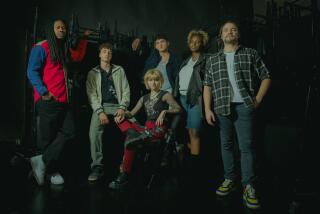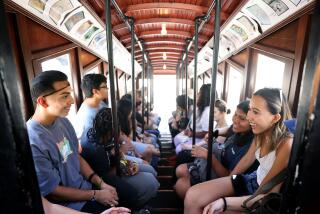Signs of Friendship : Informal Group of Deaf Meet Regularly in Grand Central Market
At Grand Central Public Market late on a recent morning, a pleasant dinfills the air as shoppers swarm the open-air food stalls, sniffing the meats, squeezing the produce and haggling over prices in several different languages.
The hubbub of hundreds of people prowling for bargains does not reach the ears of a small group of regular visitors, who are attracting some curious stares.
Two women and five men, ranging in age from 30 to 70, are seated around a couple of pushed-together tables in the dining area, immersed in conversation.
That would not be extraordinary--except that their hands are doing all the talking.
The members of this group are deaf and communicate mainly through sign language. Nearly every day before noon, they congregate at Grand Central for a kaffee klatsch that often turns heads among the other customers.
“Some people look at us kind of strange,” Francisco Salgado, 32, said through a sign-language interpreter, “but we don’t care. We come here to chat and meet friends. It’s like home.”
Grand Central, which will observe its 75th anniversary next year, is not widely known as a hangout for the deaf. Only about 15 belong to the informal social club that regularly assembles there.
According to its members, the group has remained small because it takes an adventuresome spirit to brave downtown’s traffic congestion, smoggy air and array of street characters. They find the historic marketplace to be a comfortable refuge in the concrete jungle.
Downtown is “smelly from all the cars--not very healthy,” said Dixie Savatovic, 31, who often attends with her husband, Radovan. But Grand Central is “real nice . . . very friendly.”
The deaf customers--who include two Mexico natives, one Yugoslav, a New Yorker of Ukrainian descent and an Italian-American--have been meeting for about three years, since the market’s owners installed dining tables near the Hill Street entrance as part of an ongoing $21-million renovation project.
They represent one piece of a human mosaic that forms every day around the collection of 50 food stalls at 3rd Street and Broadway. Of the 20,000 to 50,000 people a day who tread across the market’s sawdust-covered floors, the majority are working-class Latinos. Also part of the mix are a sprinkling of white-collar workers from downtown high-rises, pensioners from nearby hotels, bunches of camera-toting tourists and a handful of panhandlers. According to a market survey, at least 12 languages are spoken by merchants and customers. Sign language brings the count to 13.
Grand Central does not make any special effort to draw the deaf, although it just so happens that assistant manager Ron Duran is fluent in sign language. Duran, who can hear, said he picked up the skill in college where he had a number of deaf friends.
General manager Tracy Lyon speculated that deaf people feel comfortable at the market because it tolerates diversity well. An international potpourri of merchants--Koreans, Armenians, Chinese, Arabs, Ecuadoreans, Germans, Portuguese, Russians, Japanese and Filipinos--man the stalls, he proudly noted. “I call it the people’s market,” he said. “It’s a place where all kinds of people can come without being intimidated.”
Usually no more than about half a dozen of the deaf show up on any given day.
Most live in downtown apartments or hotel rooms, while others ride the bus from Pilgrim Tower, a residential complex for the deaf on Vermont Avenue near Koreatown.
Several have been friends for years. Others, such as Salgado, met for the first time at Grand Central.
On a recent Tuesday, Salgado, clutching a soda and a shoulder bag holding the novelty items he peddles for a living, was the first to arrive. Married and the father of three girls, he is the newest member of the group, catching a bus near his home in Pomona several times a month to join the kaffee klatsch.
Signing with clear, graceful motions, the winsome Salgado explained through an interpreter that he heard about the hangout from other deaf people while selling his wares on downtown’s streets.
By coincidence, as he was waiting for other members of the group to arrive, a woman with a child holding a balloon approached the table where he was sitting. A burst of hand signals ensued. She was an old friend from Tijuana, also deaf, whom Salgado had not seen in years, and by chance they had a surprise reunion at the market.
Soon, two more regulars appeared--Violet Donnelly, a 76-year-old retiree who has an apartment across the street at Angelus Plaza, and Marco Jimenez, 42, who lives in an apartment building on 7th Street. They had come from breakfast at Clifton’s cafeteria, another downtown institution and favorite gathering spot for many deaf people they know.
Manny Chargoy, 63, strode in a few minutes later, bearing a bag of pan dulce from one of the market’s stalls.
“I like coming here, gossiping, learning different things, having fun and laughing,” said the group’s unofficial head, a transplanted New Yorker whom the others teasingly call their “king.”
Next came Radovan and Dixie Savatovic, who are newlyweds and neighbors of Chargoy at Pilgrim Tower. Jimmy Caggiano, a sprightly septuagenarian with a lottery ticket peeking out of his shirt pocket, is last to arrive.
For the next few hours, their hands and fingers fluttered through the air, some in easy, flowing motions, others more deliberate and precise.
Radovan Savatovic, who emigrated from Yugoslavia six years ago, asked the others if they had heard about the latest turmoil in Slovenia. Dixie, unemployed, talked about looking for work. Caggiano mentioned that he loves to hang out in Chinatown, an admission that prompted a teasing rebuke from Chargoy, who pronounces Grand Central a much finer hangout--and safer than it used to be.
“It used to be awful here. People were bothering you all the time, selling drugs,” Chargoy said in his rapid-fire “New York-style” of signing.
In the last few years, Chargoy said, a lot of the shady characters have been driven away by security guards hired by the market. Nowadays, he and the others remarked, you can even rub shoulders with a celebrity. Recently, the group met Marlee Matlin, the deaf, Academy Award-winning actress from the movie “Children of a Lesser God,” who had gone to the market to film a television pilot.
Suddenly, someone in the group spotted a dour-faced woman in a lavender sweater standing a few yards away. Her appearance sent their table into a minor tizzy. This woman, Chargoy said, is a panhandler who pretends to be deaf. Caggiano frowned and stood up to see if she was bothering anybody.
“She gives deaf people a bad name,” he said.
The woman took a seat at the chop suey counter nearby. Soon, the group forgot about her, moving on to other subjects.
By about 3 p.m., their conversations began to wind down. The market, too, was in a lull; its aisles were less crowded and a few merchants took a moment to just watch the passing parade.
Chargoy pushed back his chair, ready to catch a bus home. The others, following his cue, started to gather up their things.
Tomorrow, they would be back.
More to Read
Sign up for Essential California
The most important California stories and recommendations in your inbox every morning.
You may occasionally receive promotional content from the Los Angeles Times.











